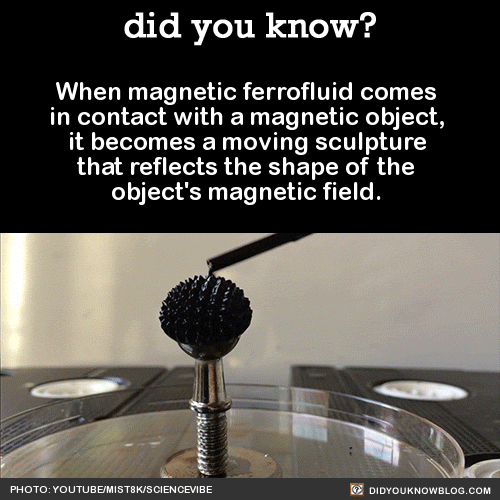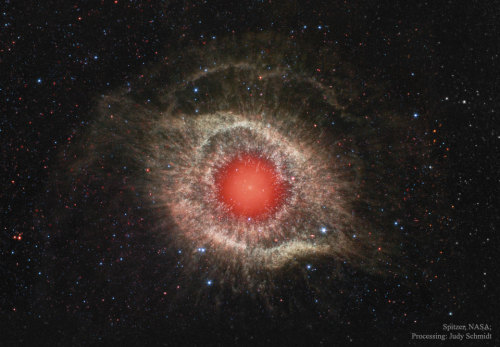We Have Been Expecting You Mr Handle......
We have been expecting you Mr Handle......
More Posts from Samstein1012 and Others

When magnetic ferrofluid comes in contact with a magnetic object, it becomes a moving sculpture that reflects the shape of the object’s magnetic field. Source

The arrangement of the spiral arms in the galaxy Messier 63, seen here in an image from the NASA/ESA Hubble Space Telescope, recall the pattern at the center of a sunflower. So the nickname for this cosmic object -- the Sunflower Galaxy -- is no coincidence. Discovered by Pierre Mechain in 1779, the galaxy later made it as the 63rd entry into fellow French astronomer Charles Messier's famous catalogue, published in 1781. The two astronomers spotted the Sunflower Galaxy's glow in the small, northern constellation Canes Venatici (the Hunting Dogs). We now know this galaxy is about 27 million light-years away and belongs to the M51 Group -- a group of galaxies, named after its brightest member, Messier 51, another spiral-shaped galaxy dubbed the Whirlpool Galaxy. Galactic arms, sunflowers and whirlpools are only a few examples of nature's apparent preference for spirals. For galaxies like Messier 63 the winding arms shine bright because of the presence of recently formed, blue-white giant stars and clusters, readily seen in this Hubble image. Image credit: ESA/Hubble & NASA Text credit: European Space Agency Hubble Space Telescope

Pluto in Combined Color
What is fascinating about Pluto is how young its surface is. We can see some canyons, planes, and mountains in this image - which is an indication of a young surface. This image of Pluto was taken when the New Horizons spacecraft was only 280,000 miles away from the surface. In the image you can see features as small as 1.4 miles! Four images from New Horizons’ Long Range Reconnaissance Imager (LORRI) were combined with color data from the Ralph instrument to create this enhanced color global view.
Credit: John’s Hopkin’s APL/NASA JPL

Helix Nebula // NGC 7293

NASA tested new “eyes” for its next Mars rover mission on a rocket built by Masten Space Systems in Mojave, California, thanks in part to NASA’s Flight Opportunities Program, or FOP.
The agency’s Jet Propulsion Laboratory in Pasadena, California, is leading development of the Mars 2020 rover and its Lander Vision System, or LVS. In 2014, the prototype vision system launched 1,066 feet (325 meters) into the air aboard Masten’s rocket-powered “Xombie” test platform and helped guide the rocket to a precise landing at a predesignated target. LVS flew as part of a larger system of experimental landing technologies called the Autonomous Descent and Ascent Powered-flight Testbed, or ADAPT.
LVS, a camera-based navigation system, photographs the terrain beneath a descending spacecraft and matches it with onboard maps allowing the craft to detect its location relative to landing hazards, such as boulders and outcroppings.
The system can then direct the craft toward a safe landing at its primary target site or divert touchdown toward better terrain if there are hazards in the approaching target area. Image matching is aided by an inertial measurement unit that monitors orientation.
The Flight Opportunities Program funded the Masten flight tests under the Space Technology Mission Directorate. The program obtains commercial suborbital space launch services to pursue science, technology and engineering to mature technology relevant to NASA’s pursuit of space exploration. The program nurtures the emerging suborbital space industry and allows NASA to focus on deep space.
Andrew Johnson, principal investigator in development of the Lander Vision System development, said the tests built confidence that the vision system will enable Mars 2020 to land safely.
“By providing funding for flight tests, FOP motivated us to build guidance, navigation and control payloads for testing on Xombie,” Johnson said. “In the end we showed a closed loop pinpoint landing demo that eliminated any technical concerns with flying the Lander Vision System on Mars 2020.”
According to “Lander Vision System for Safe and Precise Entry Descent and Landing,” a 2012 abstract co-authored by Johnson for a Mars exploration workshop, LVS enables a broad range of potential landing sites for Mars missions.
Typically, Mars landers have lacked the ability to analyze and react to hazards, the abstract says. To avoid hazards, mission planners selected wide-open landing sites with mostly flat terrain. As a result, landers and rovers were limited to areas with relatively limited geological features, and were unable to access many sites of high scientific interest with more complex and hazardous surface morphology. LVS will enable safe landing at these scientifically compelling Mars landing sites.
An LVS-equipped mission allows for opportunities to land within more challenging environments and pursue new discoveries about Mars. With LVS baselined for inclusion on Mars 2020, the researchers are now focused on building the flight system ahead of its eventual role on the Red Planet.
To learn more about NASA’s flight opportunities program, visit:
https://flightopportunities.nasa.gov/
To read more about NASA’s Mars 2020 rover, visit:
http://mars.nasa.gov/mars2020/
Profile of a World War 2 Test Pilot
'NASA's Hubble Telescope Detects ‘Sunscreen' Layer on Distant Planet': via #NASA_APP
Vote for Space at SXSW 2017
We need your help! There are a number of exciting space-related panels proposed for next year’s South by Southwest Interactive Festival in Austin, Texas. SXSW is a community-driven event and voting accounts for 30% of the decision-making process for any given programming slot. The selection process is extremely competitive and the more votes we submit for the space panels, the more likely a panel related to space exploration will be included in the final SXSW program.

To help you out as you consider what to vote for, we’ve put together a list of all the NASA-related panel proposals.
These proposals look at ways we explore the solar system and beyond:
New Eyes on our Home System: NASA’s Next Telescope
Dark Energy and Exoplanets: NASA’s WFIRST Mission
Capturing NASA’s James Webb Space Telescope
Lessons from the Fringes of the Solar System
Into the Unknown: The People Behind Webb Telescope
These proposals looks at how we’re using out-of-this-world tech and data to create incredible experiences here on Earth and helping solve challenges through your participation:
Space 360: Experience NASA Missions in VR/AR/video
The Power of Many: Wisdom from the Crowd
It’s Time to Ask More of Open Data
A little closer to home, this proposal explores our work to study and observe our dynamic home world, Earth:
NASA - Doing Work to Keep it Cool
We want to send humans on a journey to Mars. How? These proposals would dive into this question and more:
So you want to go to Mars?
Humans, Robots + Microbes: The Challenge of Mars
“Because They Are Hard”: NASA & Mars
Lastly, we’re proposing a meetup for NASA and the entire space community at SXSW 2017:
Space Meetup
Community voting and commenting for SXSW 2017 is open through September 2, 2016.
We look forward to seeing you in Austin in March at the SXSW Interactive Festival. Thanks!
Elon Musk,Electric Cars,MIT, Spacex, NASA, Tesla and Taylor Alison Swift
34 posts
